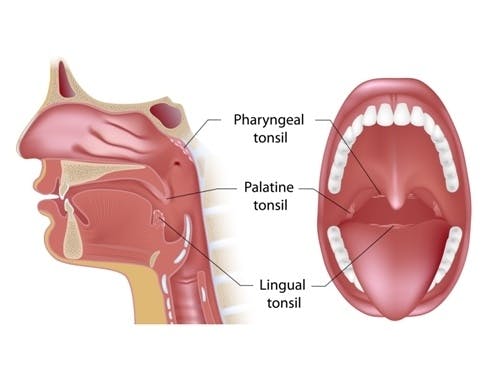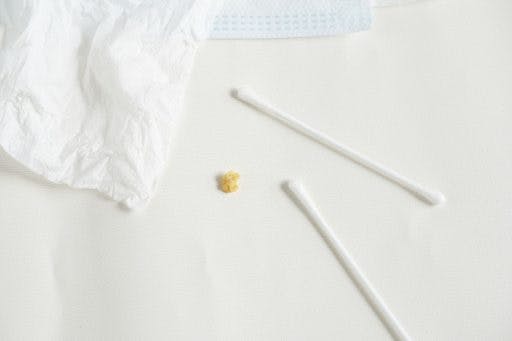Are you struggling to identify the cause of your persistent bad breath? Tonsil stones could be the culprit. These tonsillar concretions have long remained in the shadows – only to emerge into the limelight thanks to social media.
In 2021, numerous videos with intriguing titles like “Why You Keep Getting Tonsil Stones,” “Home Remedy for Tonsil Stones,” and “How I Removed my Tonsil Stones at Home” flooded TikTok. A study published by the Ear, Nose, & Throat Journal described the content as “intraoral ‘selfies’ of teenagers showing large tonsillar concretions or debris-filled tonsillar crypts with do-it-yourself techniques for management.”
The authors discovered that the videos garnered millions of views but also caused anxiety among viewers and significant injuries due to untested remedies. Thus, they emphasised the need to educate the public on proper tonsil stone management.
So, how do tonsil stones appear, and what are their causes, symptoms, and treatment options? Read on to find out.
What are tonsil stones?

Healthdirect Australia defines them as “small lumps of hardened material that can form in the tonsils.” Also called tonsilloliths, they are white or yellowish calcified bodies packed with bacteria and organic debris, including calcium salts, oxalates, magnesium salts, and ammonium radicals.
Tonsil stones are commonly small (1-2mm), single, and unilateral (forming on one side) but can occasionally be multiple or bilateral (on both sides). They can be soft and friable or hard as a stone. They typically occur among adults aged 20-60 and are rare in children.
What causes tonsil stones?
According to the Journal of Clinical and Diagnostic Research (JCDR), the formation of stones, results from the calcification in the crypts (folds) of the tonsils, sometimes associated with chronic tonsillitis.
These crypts increase the tonsils’ surface area. Think of them as the nooks and crannies in the tissue lining your throat. You might ask, “Why do tonsil stones smell so bad?” Cellular debris, food, and microorganisms can accumulate in these chambers, harden, and gradually enlarge.
Bacteria and debris buildup can accumulate in the throat due to various factors, including:
- Poor oral hygiene: Neglecting proper dental care can create an environment where harmful microorganisms thrive in the mouth.
- Malocclusion: Misaligned or crowded teeth create spaces that easily trap food particles and bacteria. Crooked teeth also make it more challenging to clean these crevices, leading to increased bacterial buildup.
- Tonsillitis: Inflammation of the tonsils can increase the risk of stone formation.
- Post-nasal drip: When mucus accumulates in the back of the throat, it can harden and form tonsil stones over time.
Symptoms of tonsil stones

Small concretions may remain asymptomatic. Often, they are detected incidentally through dental examinations and radiographic imaging. But larger formations may manifest through these signs and symptoms:
- Halitosis or bad breath
- Chronic sore throat
- Foreign body sensation
- Swollen sinus
- Painful swallowing
- Hoarseness
- Ear pain
- Peritonsillar abscess
- Irritable cough
- Foul taste in the mouth
- Upper airway obstruction (in rare cases)
The link between tonsil stones and bad breath
Countless scientific studies have established the link between tonsil stones and halitosis. A study published in the Ear, Nose, & Throat Journal confirmed this connection. Another review in the Journal of Otolaryngology Head and Neck Surgery found that approximately 3% of cases of bad breath derive from tonsilloliths or tonsil stones.
In a study published in Microbes and Infection, researchers assessed the bacterial composition of tonsil stones. They discovered that the anaerobic bacteria in tonsil stones belong to genera associated with producing odorous volatile sulfur compounds. They also verified that the concretions emit a foul smell when crushed.
The study also reported that removing tonsil stones in a patient complaining of oral malodour led to better breath. Additionally, it referenced another case report that showed the effectiveness of surgically removing tonsils with stones in treating bad breath.
How to prevent tonsil stones
You can take precautions to prevent the formation of tonsil stones. Simple habits like brushing twice a day can go a long way to keep your mouth healthy. Here are some tips to follow:
- Practise good oral hygiene.
- Gargle with warm salt water or mouthwash.
- Visit your dentist regularly for consultation and cleaning.
Tonsil stones removal and treatment options

According to Healthdirect Australia, tonsil stones are “not harmful and may not need to be treated.” In many cases, they can fall out without any form of intervention.
If the tonsil stones become too large and bothersome, seek advice from a healthcare professional. They can examine your condition and suggest the most appropriate solution, whether surgical removal, antibiotics, or laser cryptolysis.
Treating tonsil stone causes and symptoms
When you’re considering how to treat tonsil stones, there are a range of things to consider, from the cause and your symptoms and whether tonsil removal is necessary. The first point of call should be speaking to your doctor.
As mentioned above, crooked teeth can increase bacteria buildup and your chances of having tonsil stones. Consider orthodontic devices like ClearCorrect aligners, which fix teeth alignment discreetly and comfortably thanks to their cutting-edge ClearQuartz material and flat trimline technology.
Tonsil stones may be generally harmless, but they can cause embarrassing bad breath. Combat the issue by doubling down on your oral hygiene practices. Brush meticulously, floss regularly, and make sure you reach the crevices between your teeth to prevent food and bacteria buildup. Wave goodbye to those pesky lumps and embrace your newfound confidence!
References:
Al-Fayez, A. I., Albesher, M. B., & Alqabasani, M. A. (2018). A giant tonsillolith. Saudi Medical Journal.
B, B. T. V., A, T. M. L., & Ck, A. (2013). Tonsillolith: A Panoramic Radiograph Presentation. Journal of Clinical and Diagnostic Research.
Bamgbose, B. O., Ruprecht, A., Hellstein, J. W., Timmons, S., & Qian, F. (2014). The Prevalence of Tonsilloliths and Other Soft Tissue Calcifications in Patients Attending Oral and Maxillofacial Radiology Clinic of the University of Iowa. ISRN Dentistry (Print), 2014, 1–9.
Chang, C. J., & Thrasher, R. (2012). Coblation Cryptolysis to Treat Tonsil Stones: A Retrospective Case Series. Ear, Nose, & Throat Journal, 91(6), 238–254.
Ferguson, M. L., Aydin, M., & Mickel, J. (2014). Halitosis and the Tonsils. Otolaryngology-Head and Neck Surgery, 151(4), 567–574.
Healthdirect Australia. (n.d.). Tonsil stones. Symptoms, Treatments and Causes | Healthdirect.
Ram, S., Siar, C. H., Ismail, S. Z., & Prepageran, N. (2004). Pseudo bilateral tonsilloliths: a case report and review of the literature. Oral Surgery Oral Medicine Oral Pathology Oral Radiology and Endodontology, 98(1), 110–114.
Smith, K. L. (n.d.). Tonsillitis and Tonsilloliths: Diagnosis and Management. AAFP.
Sulibhavi, A., & Isaacson, G. (2021). TikTok Tonsils. Ear, Nose, & Throat Journal, 014556132110383.
Tsuneishi, M., Yamamoto, T., Kokeguchi, S., Tamaki, N., Fukui, K., & Watanabe, T. (2006). Composition of the bacterial flora in tonsilloliths. Microbes and Infection, 8(9–10), 2384–2389.



